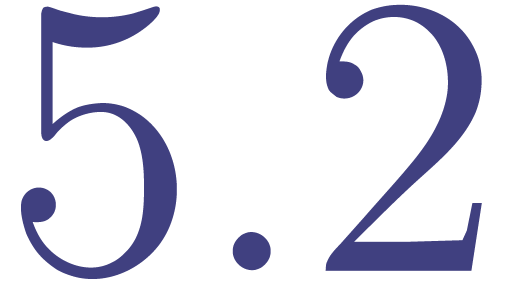It is well known that the operation of integration may lead to
divergent formal expansions like |
|
It is well known that the operation of integration may lead to
divergent formal expansions like |
A natural way to solve a differential equation like
 |
(1.1) |
for large  is to rewrite it in integral form
is to rewrite it in integral form
 |
(1.2) |
and recursively replace the left-hand side by the right-hand side. This
yields a convergent expansion for  as an
“integral transseries”
as an
“integral transseries”
 |
(1.3) |
More generally such infinite sums can occur recursively in the exponents. The aim of this paper is to develop a systematic calculus for integral transseries.
We will work in the context of complex grid-based transseries [vdH01], which is briefly recalled in section 2. An “integral transseries” is an infinite linear combination of “integral transmonomials”, which are finite expressions formed from certain “elementary monomials” using multiplication and integration. The elementary monomials are exponentials of integrals of “simpler” integral transseries. The representation of a complex transseries by an integral transseries is far from being unique, which provides a lot of flexibility for the computation with integral transseries.
A major aim of the theory is to lift the usual operations on complex
transseries, such as differentiation, truncation, division,
etc., to their representations by integral transseries.
Moreover, we want these operations to preserve “combinatorial
convergence”. For instance, even though the transseries
represented by  in (1.3) is not
convergent, the expansion is said to be combinatorially convergent as an
integral transseries. Indeed, the main reason of being for integral
transseries is that they allow us to maintain a formal notion of
convergence during our computations, there where the represented
transseries themselves are divergent.
in (1.3) is not
convergent, the expansion is said to be combinatorially convergent as an
integral transseries. Indeed, the main reason of being for integral
transseries is that they allow us to maintain a formal notion of
convergence during our computations, there where the represented
transseries themselves are divergent.
Before introducing integral transseries in their full generality, we first introduce the simpler notion of integral series in sections 3, 4 and 5. A first technical difficulty is to impose suitable conditions on the supports of integral series. Since we work in the grid-based context, we need a suitable analogue of the grid-based finiteness property. This involves two ingredients: finite generation (cf. regular language specifications in section 5.1) and an asymptotic descent condition (cf. the cycle condition in section 5.2), which states roughly speaking that later terms in the expansion are smaller and smaller from an asymptotic point of view. Moreover, because integral monomials represent series and not merely monomials, we need this descent condition to be sufficiently uniform. This motivates the introduction of the span of an integral series in section 4.3 and frameworks in section 4.4. These notions allow to obtain quick and rough bounds for the support of the transseries represented by an integral series or monomial.
In order to lift computations with classical complex transseries to integral transseries, the key step is a mechanism for rewriting integral transseries in a form with a clear asymptotically dominant part. For instance, in order to compute a fraction

it is necessary to first expand the denominator in such a way that it can be inverted. Using integration by parts, one has
whence

Now  admits a natural “integral
transseries” inverse
admits a natural “integral
transseries” inverse  .
A more systematic procedure for obtaining expansions like (1.4)
and (1.5) will be the object of sections 7 and
8. In section 6, we prepare this material by
introducing the integral transseries analogue of transbases and
differentiation. Putting all techniques together, we finally construct
the field of integral transseries in section 9.
.
A more systematic procedure for obtaining expansions like (1.4)
and (1.5) will be the object of sections 7 and
8. In section 6, we prepare this material by
introducing the integral transseries analogue of transbases and
differentiation. Putting all techniques together, we finally construct
the field of integral transseries in section 9.
Integral transseries can be seen as a natural generalization of Écalle's arborified moulds [EV04]. One advantage of the approach in this paper is that a systematic calculus for integral transseries avoids the process of “arborification”. Even though the latter technique also has a large degree of generality, our technique works in a context as general as that of complex transseries, for which a satisfactory theory of accelero-summation is not even known yet (but under development). Furthermore, with more work, we think that our technique may be generalized so as to include other types of operators, like infinite summation, and parameterized transseries. Unfortunately, we also have to pay the price of a certain technicity in sections 7 and 8. It remains an interesting question how far the ideas in this paper may be further simplified. A few ideas in this direction will be mentioned in the conclusion. We plan to further develop the topic of integral transseries and its link with the theory of accelero-summation in a forthcoming paper.
The field of complex grid-based transseries has been constructed and
studied in [vdH01]. Below we will quickly present a
classical variant of the construction. We first endow  with the following total ordering:
with the following total ordering:

This gives  the structure of a totally ordered
the structure of a totally ordered
 -vector space, although the
ordering is not compatible with the multiplication.
-vector space, although the
ordering is not compatible with the multiplication.
Remark  and vary the orderings during the construction [vdH01].
However, in this paper, we will assume the above ordering, for
simplicity.
and vary the orderings during the construction [vdH01].
However, in this paper, we will assume the above ordering, for
simplicity.
Now consider the totally ordered monomial groups  and corresponding fields
and corresponding fields  ,
which are inductively defined by
,
which are inductively defined by

We call

the field of purely exponential complex transseries. Setting

we have  , because of the
grid-based property. For each
, because of the
grid-based property. For each  ,
let
,
let  denote the field obtained from
denote the field obtained from  when replacing
when replacing  by
by  . We call
. We call

the field of complex transseries. Setting

we again have  , because of
the grid-based property.
, because of
the grid-based property.
Remark  under exponentiation and next under logarithm. In [vdH01],
we proceed exactly the other way around.
under exponentiation and next under logarithm. In [vdH01],
we proceed exactly the other way around.
We recursively define a strong derivation on  , by setting
, by setting

for monomials  and extending by strong linearity.
Next, we set
and extending by strong linearity.
Next, we set

for  . It is classical to
verify that
. It is classical to
verify that  is a strong derivation which
satisfies
is a strong derivation which
satisfies
 |
(2.1) |
For all  , the logarithmic
derivative of
, the logarithmic
derivative of  is denoted by
is denoted by  .
.
Using general strongly linear algebra, it follows from (2.1)
that  admits a distinguished strong right inverse
admits a distinguished strong right inverse
 , i.e.
, i.e.  for all
for all  . More
specifically, one has
. More
specifically, one has
 |
(2.2) |
for all transmonomials  . It
can also be checked that
. It
can also be checked that  and
and  are stable under integration for all
are stable under integration for all  (and
similarly for
(and
similarly for  and
and  ).
In particular, we have
).
In particular, we have

in the inductive construction of  .
.
In this paper, the flatness relations  ,
,
 ,
,  and
and
 are defined in an
are defined in an  -expo-linear
way:
-expo-linear
way:

For instance,  and
and  .
A subset
.
A subset  of
of  is said to
be flat if
is said to
be flat if  for all
for all  . We denote by
. We denote by  the set
of all flat subsets. We have
the set
of all flat subsets. We have  and
and  is stable under arbitrary intersections.
is stable under arbitrary intersections.
Remark  , where
, where  is a partially ordered monomial group which admits powers
in a totally ordered ring
is a partially ordered monomial group which admits powers
in a totally ordered ring  with
with  . In that case, we set
. In that case, we set

The definitions remain valid if  is only a
partially ordered monomial monoid which can be embedded into a partially
ordered group.
is only a
partially ordered monomial monoid which can be embedded into a partially
ordered group.
Given  , we define the
flattened dominance and neglection relations
, we define the
flattened dominance and neglection relations  ,
,  ,
,  and
and  by
by

We also define the derived relations  ,
,
 ,
,  and
and
 by
by

Notice that  and
and 
The differentiation  and the distinguished
integration
and the distinguished
integration  on
on  satisfy
satisfy

for all  (the first relation is easily checked
and the second one follows from relation follows from (2.2)).
We say that
(the first relation is easily checked
and the second one follows from relation follows from (2.2)).
We say that  and
and  are
flat.
are
flat.
Remark  -expo-linear
way using
-expo-linear
way using

Equivalently, we may define them using

When replacing  and
and  by
the relations
by
the relations  and
and  defined by
defined by

it is also possible to recover the  -expo-linear
case.
-expo-linear
case.
Classically, a transbasis is a tuple  of
transseries with
of
transseries with  and such that
and such that
 for some
for some  .
.
 for all
for all  .
.
The integer  is called the level of the
transbasis and
is called the level of the
transbasis and  is said to be a plane
transbasis if
is said to be a plane
transbasis if  . We recall
that the flatness relations
. We recall
that the flatness relations  and
and  were defined in an
were defined in an  -expo-linear
way, whence
-expo-linear
way, whence  . We denote by
. We denote by
 the set of power products
the set of power products  with
with  . The level of
a transseries
. The level of
a transseries  is the highest
is the highest  such that
such that  .
.
In this paper, it will be convenient to consider a variant of the
concept of transbases. Given  ,
consider the differentiation
,
consider the differentiation

A differential transbasis of level  is a
tuple
is a
tuple  of transseries with
of transseries with  and such that
and such that
 for all
for all  .
.
We will sometimes denote  . We
notice that
. We
notice that  is stable under
is stable under  for all
for all  and it has been proved in [vdH01]
that
and it has been proved in [vdH01]
that  is stable under
is stable under  .
.
In what follows, all transbasis will be considered to be differential. The following incomplete transbasis theorem is proved in a similar way as the usual theorem for non-differential transbases [vdH97]:
 be a transbasis of level
be a transbasis of level
 and
and  a transseries of
level
a transseries of
level  . Then there exists a
transbasis
. Then there exists a
transbasis  of level
of level  such that
such that  .
.
Let  be a constant field,
be a constant field,  a monomial set and let
a monomial set and let  be a strong
be a strong  -module of formal power series. Consider a set
-module of formal power series. Consider a set
 and a strong
and a strong  -module
-module
 which admits
which admits  as a strong
basis. We will call elements of
as a strong
basis. We will call elements of  monomials, even
though we do not necessarily have an ordering
monomials, even
though we do not necessarily have an ordering  on
on
 . Assume that we have a
strongly linear mapping
. Assume that we have a
strongly linear mapping

such that  is regular for all
is regular for all  . Then we call
. Then we call  a
representation module and we say that
a
representation module and we say that  represents
represents  for each
for each  . We denote by
. We denote by  the
equivalence relation on
the
equivalence relation on  defined by
defined by  . If
. If  and
and  are monoids and
are monoids and  preserves
multiplication, then we call
preserves
multiplication, then we call  a representation
algebra.
a representation
algebra.
Example  and a mapping
and a mapping  such
that
such
that  is regular for all
is regular for all  , let
, let  be the set of all
mappings
be the set of all
mappings  such that
such that  is a
summable family in
is a
summable family in  . A family
. A family
 is said to be summable if
is said to be summable if  is a summable family in
is a summable family in  , in
which case we set
, in
which case we set

The strong summation is well-defined, since  is
summable for all
is
summable for all  and
and  . The mapping
. The mapping  extends to
extends to
 by strong linearity, giving
by strong linearity, giving  the structure of a representation module. Any other representation
module with the same
the structure of a representation module. Any other representation
module with the same  and
and  on
on  can be embedded into
can be embedded into  .
.
Example  be the strong
be the strong  -algebra
of grid-based series over a monomial group
-algebra
of grid-based series over a monomial group  .
Let
.
Let  be infinitesimal monomials in
be infinitesimal monomials in  and consider the formal group
and consider the formal group  . We have a natural multiplicative mapping
. We have a natural multiplicative mapping  , which extends to
, which extends to  according to the previous example. This gives
according to the previous example. This gives  the structure of a representation algebra.
the structure of a representation algebra.
An  is called a Cartesian representation
of
is called a Cartesian representation
of  . If
. If  is generated by its infinitesimal elements, then each series in
is generated by its infinitesimal elements, then each series in  admits a Cartesian representation for a suitable
admits a Cartesian representation for a suitable
 .
.
Example  be a representation module with representation
mapping
be a representation module with representation
mapping  . A support
function is a mapping
. A support
function is a mapping  with
with  for all
for all  . Given
. Given  , we set
, we set  ,
so that
,
so that  .
.
A family  to be
to be  -summable
if
-summable
if  is finite for all
is finite for all  . The subset
. The subset  of
of  of all
of all  such that
such that  is
is  -summable is a
representation module for the
-summable is a
representation module for the  -summability
relation. We have
-summability
relation. We have  for the trivial support
function with
for the trivial support
function with  for all
for all  .
.
Let  be a representation module with
representation mapping
be a representation module with
representation mapping  and a support function as
in example 3.3. Given
and a support function as
in example 3.3. Given  and
and  , we denote
, we denote

A strongly linear operator  is said to be a
truncation operator w.r.t.
is said to be a
truncation operator w.r.t.  ,
if
,
if
 .
.
For all  , we have
, we have  .
.
For all  , we have
, we have  .
.
Two truncation operators  and
and  are said to be compatible if they commute. In that case,
are said to be compatible if they commute. In that case,  is again a truncation operator.
is again a truncation operator.
Let  be a set of subsets of
be a set of subsets of  , which is closed under complements and finite
intersections. Then we say that
, which is closed under complements and finite
intersections. Then we say that  is
is  -truncation-closed if for each
-truncation-closed if for each
 , there exists a truncation
operator
, there exists a truncation
operator  for each
for each  ,
and
,
and  for all
for all  .
In what follows, given
.
In what follows, given  , we
will sometimes use the notations
, we
will sometimes use the notations  ,
,
 , etc.
, etc.
Example

for all subsets  of
of  ,
where
,
where

Let  be a strong differential
be a strong differential  -algebra for the derivation
-algebra for the derivation  . Assume that
. Assume that  admits a regular and distinguished right inverse
admits a regular and distinguished right inverse  . Let
. Let  be a monomial group
together with a multiplicative mapping
be a monomial group
together with a multiplicative mapping  such that
such that
 is regular for all
is regular for all  .
In what follows, we will assume that
.
In what follows, we will assume that  for
for  .
.
We denote by  the free formal structure generated
by
the free formal structure generated
by  ,
,  and
and  . In other words, each
element
. In other words, each
element  is a tree whose leafs are labeled by
elements in
is a tree whose leafs are labeled by
elements in  , whose unary
nodes are labeled by
, whose unary
nodes are labeled by  , and
whose binary nodes are labeled by
, and
whose binary nodes are labeled by  .
For instance, if
.
For instance, if  , then the
following tree is an element of
, then the
following tree is an element of  :
:

We will denote by  the size of
the size of  , i.e. the number of leafs plus
the number of integral nodes of the tree
, i.e. the number of leafs plus
the number of integral nodes of the tree  .
We denote by
.
We denote by  the total size of
the total size of  , i.e. when we also count
multiplicative nodes. For instance, the size of the above example tree
is
, i.e. when we also count
multiplicative nodes. For instance, the size of the above example tree
is  and its total size
and its total size  . We denote by
. We denote by  the finite
subset of
the finite
subset of  of leafs of
of leafs of  . Elements of
. Elements of  are called
integral monomials. It may sometimes be useful to assume the
existence of a special integral node monomial
are called
integral monomials. It may sometimes be useful to assume the
existence of a special integral node monomial  of
size
of
size  .
.
Each integral monomial  induces a natural element
induces a natural element
 . Indeed, this was already
assumed if
. Indeed, this was already
assumed if  . If
. If  resp.
resp.  ,
then we recursively set
,
then we recursively set

We also recursively define a non-trivial support function  by
by

We let  denote the (non-associative)
representation algebra from example 3.3. Elements of
denote the (non-associative)
representation algebra from example 3.3. Elements of  are called integral series and we call
are called integral series and we call  a representation algebra of integral series
with underlying monomial group
a representation algebra of integral series
with underlying monomial group  .
For each
.
For each  , we denote
, we denote  .
.
Remark  is not associative nor
commutative. In the sequel of this paper, this will not be a problem,
since integral transseries are mainly used for the purpose of
representation. Nevertheless, it is possible to define an associative
(and/or commutative) variant of
is not associative nor
commutative. In the sequel of this paper, this will not be a problem,
since integral transseries are mainly used for the purpose of
representation. Nevertheless, it is possible to define an associative
(and/or commutative) variant of  .
.
Let  be the equivalence relation on
be the equivalence relation on  generated by all relations of the form
generated by all relations of the form  . This relation is compatible with the
representation mapping
. This relation is compatible with the
representation mapping  as well as the size
function
as well as the size
function  . Assuming that
. Assuming that
 , it follows that
, it follows that  has the structure of a multiplicative monoid and
has the structure of a multiplicative monoid and  has the structure of an associative representation
algebra. The mapping
has the structure of an associative representation
algebra. The mapping  naturally factors through
naturally factors through
 .
.

The mapping  naturally extends by strong
linearity to
naturally extends by strong
linearity to  . Indeed, given
. Indeed, given
 there is at most one
there is at most one  with
with  . Similarly, the
multiplication
. Similarly, the
multiplication  extends to a strongly bilinear
mapping
extends to a strongly bilinear
mapping  . Given
. Given  , we denote by
, we denote by  and
and  the strongly linear operators on
the strongly linear operators on  with
with

The operators  ,
,  and
and  (for monomials
(for monomials  ) admit strongly linear left inverses
) admit strongly linear left inverses  ,
,  and
and  whose action on monomials is given by
whose action on monomials is given by

Let  be such that
be such that  .
Then we claim that
.
Then we claim that

is a well-define multiplicative inverse of  modulo
modulo  . Indeed,
. Indeed,  . Moreover, given
. Moreover, given  and
and
 with
with  ,
we must have
,
we must have  .
.
Consider an exponential transmonomial  with
with  . Then
. Then

For arbitrary transmonomials  it follows that
it follows that

for a sufficiently large  .
For such an
.
For such an  , we define the
integral span of
, we define the
integral span of  by
by

We have

Example  ,
,  and
and  . Notice that
. Notice that

Assume now that  . For
integral monomials
. For
integral monomials  , we
recursively define the span of
, we
recursively define the span of  by
by

We have

For  such that
such that  is finite
(we say that
is finite
(we say that  has finitely generated
support), we define
has finitely generated
support), we define  .
.
Example  .
.
A framework is a set  of subsets of
of subsets of  which is closed under arbitrary intersections and
such that
which is closed under arbitrary intersections and
such that  for each
for each  .
The elements of
.
The elements of  will be called frames.
For each subset
will be called frames.
For each subset  there exists a smallest frame
which contains
there exists a smallest frame
which contains  and we denote it by
and we denote it by  .
.
Example  is a monomial group and define the flatness
relations as in remark 2.3. Then the set
is a monomial group and define the flatness
relations as in remark 2.3. Then the set

is a framework. Indeed, if  is a family of
elements in
is a family of
elements in  with
with  ,
then
,
then  for any
for any  .
If
.
If  is only a monomial monoid which can be
embedded in a monomial group
is only a monomial monoid which can be
embedded in a monomial group  ,
then
,
then  is again a framework.
is again a framework.
A framework function on  is a function
is a function
 which associates a frame
which associates a frame  to each integral monomial
to each integral monomial  ,
so that
,
so that

In particular,  for all
for all  . We call
. We call  the frame for
the frame for
 . More generally, given a set
. More generally, given a set
 of integral monomials, we call
of integral monomials, we call

the frame for  . Given a
representation algebra
. Given a
representation algebra  of integral series with a
framework function
of integral series with a
framework function  as above, we call
as above, we call  a framed representation algebra.
a framed representation algebra.
Example  . Taking
. Taking

for all  , we define a
framework function on
, we define a
framework function on  .
.
Given an integral series  ,
the number of integral monomials
,
the number of integral monomials  with
with  is finite for each fixed size
is finite for each fixed size  . Therefore, we may define the majorating
series
. Therefore, we may define the majorating
series  for
for  by
by

We say that  is combinatorially
convergent if
is combinatorially
convergent if  is convergent. We will denote
the set of combinatorially convergent series in
is convergent. We will denote
the set of combinatorially convergent series in  by
by  .
.
Proof. This follows immediately from the facts
that for all  , we have
, we have

Here  for
for  if
if  for all
for all  .
.
A family  of elements in
of elements in  is said to be summable if
is said to be summable if  is a summable
family of power series in
is a summable
family of power series in  .
In other words,
.
In other words,  is finite for each
is finite for each  and
and  . The set
. The set
 is a strong
is a strong  -module
for this infinite summation operator.
-module
for this infinite summation operator.
Consider a strongly linear mapping  .
For each
.
For each  , let
, let  . We call
. We call  the
majorant series for
the
majorant series for  .
Notice that
.
Notice that  is uniquely determined by the
restriction of
is uniquely determined by the
restriction of  to
to  .
We may also regard
.
We may also regard  as a mapping on
as a mapping on  by setting
by setting  . We
have
. We
have

for all  . If
. If  maps
maps  into itself, then
into itself, then  maps
maps  into
into  ,
and we say that
,
and we say that  is uniformly strong.
This is the case if and only if
is uniformly strong.
This is the case if and only if  is a summable
family in
is a summable
family in  for each
for each  .
In particular, if
.
In particular, if  and there exist constants
and there exist constants  with
with  for all
for all  , then
, then  is uniformly
strong.
is uniformly
strong.
A uniformly strong mapping  is said to be a
rewriting if
is said to be a
rewriting if  for all
for all  . In that case
. In that case  is said
to be a rewriting of
is said
to be a rewriting of  and we write
and we write  . If
. If  maps
maps  into itself, then we call
into itself, then we call  a
monomial rewriting. In particular, consider a mapping
a
monomial rewriting. In particular, consider a mapping  such that there exist constants
such that there exist constants  with
with  ,
,  and
and  for all
for all  .
Then
.
Then  extends uniquely to a monomial rewriting.
extends uniquely to a monomial rewriting.
Example  by
multiplications
by
multiplications  determines a monomial rewriting.
determines a monomial rewriting.
Assume that  is the constant field for the
derivation on
is the constant field for the
derivation on  . Then for any
. Then for any
 there exists a constant
there exists a constant  with
with

Let  be the subset of
be the subset of  of
integral monomials of the form
of
integral monomials of the form

with  . We recursively define
a product
. We recursively define
a product  on
on  by
by

for all  and
and  and
extension by linearity. Here we understand that the products
and
extension by linearity. Here we understand that the products  are taken in
are taken in  .
We recursively define the mouldification
.
We recursively define the mouldification  of an
integral monomial
of an
integral monomial  by
by

This definition extends to a strongly linear mapping  .
.
For several purposes, it is more convenient to work with moulds in  than general integral series in
than general integral series in  . However, the mapping
. However, the mapping  generally destroys combinatorial convergence, i.e.
generally destroys combinatorial convergence, i.e.  is not a rewriting. The convergence can often be
restored using the process of arborification [EV04], which
corresponds more or less to inverting the mapping
is not a rewriting. The convergence can often be
restored using the process of arborification [EV04], which
corresponds more or less to inverting the mapping  in a nice way. In this paper, we will show that most important
operations can be carried out directly in
in a nice way. In this paper, we will show that most important
operations can be carried out directly in  ,
while preserving combinatorial convergence.
,
while preserving combinatorial convergence.
Throughout this section, we assume that  is a
framed representation algebra of integral series with underlying
monomial group
is a
framed representation algebra of integral series with underlying
monomial group  and framework function
and framework function  .
.
A regular language specification is a finite set  of formal language symbols, together with a rule of
one of the following forms for each
of formal language symbols, together with a rule of
one of the following forms for each  :
:
 , with
, with  ;
;
 , with
, with  ;
;
 , with
, with  ;
;
 , with
, with  .
.
The language symbols  may regarded as subsets of
may regarded as subsets of
 as follows. Consider the set
as follows. Consider the set  of mapping
of mapping  , such that for
all
, such that for
all  we have
we have  ,
,
 ,
,  , resp.
, resp.  ,
if
,
if  is specified by R1, R2,
R3 resp. R4. Then
is specified by R1, R2,
R3 resp. R4. Then  is again in
is again in
 . We will regard
. We will regard  as the subset
as the subset  of
of  . Subsets of this kind are called regular
languages.
. Subsets of this kind are called regular
languages.
Example  of
of  ,
the set
,
the set  generated by
generated by  ,
,  and
and  is a regular language. Notice that
is a regular language. Notice that  consists of
the
consists of
the  with
with  .
Inversely, given a regular language specification
.
Inversely, given a regular language specification  , let
, let  be the finite set
monomials
be the finite set
monomials  , such that
, such that  for some
for some  .
Then each
.
Then each  is contained in
is contained in  and the set
and the set  is finite for each
is finite for each  .
.
Given a regular language specification  ,
we say that
,
we say that  directly depends on
directly depends on  , and we write
, and we write  , if
, if  for some
for some  , or
, or  .
The transitive closure of the direct dependency relation
.
The transitive closure of the direct dependency relation  is denoted by
is denoted by  ;
we say that
;
we say that  depends on
depends on  , if
, if  .
The dependency relation
.
The dependency relation  is reflexive and
transitive, but not necessarily anti-symmetric, since distinct language
symbols may mutually depend on each other.
is reflexive and
transitive, but not necessarily anti-symmetric, since distinct language
symbols may mutually depend on each other.
Example

where we may take  ,
,  and the natural embedding of
and the natural embedding of  into
into
 for
for  .
We will show later that all integral monomials which occur in the
expansion (1.3) belong to
.
We will show later that all integral monomials which occur in the
expansion (1.3) belong to  .
.
Remark  from example
from example  may simply be specified by
may simply be specified by

Remark  and a language
symbol
and a language
symbol  such that
such that  for no
for no
 with
with  for some
for some  . Then
. Then  as a
subset of
as a
subset of  . A language
specification which contains no symbols
. A language
specification which contains no symbols  of the
above type is said to be well-rooted.
of the
above type is said to be well-rooted.
Let  be a regular language specification. An
arc is a sequence
be a regular language specification. An
arc is a sequence
 |
(5.1) |
such that  and for all
and for all  , we have
, we have  ,
,
 and either
and either
 or
or  and
and  .
.
 or
or  and
and  .
.
 and
and  .
.
If  , then we call (5.1)
a cycle in
, then we call (5.1)
a cycle in  . A cycle
(5.1) is said to be minimal if
. A cycle
(5.1) is said to be minimal if  . Notice that each two language symbols
. Notice that each two language symbols  and
and  in a cycle mutually
depends on each other.
in a cycle mutually
depends on each other.
We say that  satisfies the cycle
condition, if
satisfies the cycle
condition, if  for every cycle (5.1).
In that case, we say that
for every cycle (5.1).
In that case, we say that  is a grid-based
language specification and the elements of
is a grid-based
language specification and the elements of  are called grid-based languages. A grid-based subset of
are called grid-based languages. A grid-based subset of  is an arbitrary subset of a grid-based language.
Series in
is an arbitrary subset of a grid-based language.
Series in  with grid-based support are called
grid-based integral series. We denote by
with grid-based support are called
grid-based integral series. We denote by  the representation algebra of such grid-based series.
the representation algebra of such grid-based series.
Remark  to be replaced by one-step arcs
to be replaced by one-step arcs  in
the case when the languages
in
the case when the languages  are unique with the
properties that
are unique with the
properties that  and
and  for
all
for
all  .
.
Example

It is easily verified that  and
and  for all
for all  . Consequently,
. Consequently,  and
and  ,
whence
,
whence  . If we set
. If we set

then we notice that the cycle condition is no longer satisfied.
Example  is also a grid-based subset
of
is also a grid-based subset
of  .
.
Let  be a regular language specification and
define
be a regular language specification and
define

Consider a  -labeled tree
-labeled tree  with children
with children  .
Assume that the roots of
.
Assume that the roots of  are labeled by
are labeled by  . We say that
. We say that  is a derivation tree if this is recursively the case for
is a derivation tree if this is recursively the case for  and either
and either
 ,
,  and
and  .
.
 or
or  for some
for some  ,
,  and
and
 .
.
 ,
,  and
and  .
.
 ,
,  and
and  .
.
We denote by  the set of all such derivation
trees. Given
the set of all such derivation
trees. Given  , we define
, we define
 ,
,  and
and
 as follows:
as follows:
 is the product of all
is the product of all  where
where  ranges over all labels of
ranges over all labels of  .
.
 is obtained from
is obtained from  by
substituting each label
by
substituting each label  by
by  ,
,  or
or  , depending on whether
, depending on whether  ,
,  resp.
resp.  , and
by eliminating all nodes
, and
by eliminating all nodes  with
with  .
.
 , where
, where  is the label of the root of
is the label of the root of  .
.
Example  from example 5.2,
the tree
from example 5.2,
the tree

is a derivation tree  for the triple
for the triple  with
with  ,
,  and
and  .
.
Proof. We recursively construct  as follows:
as follows:
If  , then
, then  is reduced to its root labeled by
is reduced to its root labeled by  .
.
If  , then we choose
, then we choose  with
with  ,
and set
,
and set

If  ,
,  and
and  with
with 
 , then
, then

If  ,
,  and
and  with
with  and
and  , then
, then

It is easily verified by recursion that  ,
,
 and
and  .
.
If  is a derivation tree constructed as in the
proof of the proposition, then we say that
is a derivation tree constructed as in the
proof of the proposition, then we say that  is a
derivation tree for the triple
is a
derivation tree for the triple  .
For instance,
.
For instance,  is a derivation tree for
is a derivation tree for  in example 5.8.
in example 5.8.
 of a derivation
tree
of a derivation
tree  with respect to a grid-based language
specification
with respect to a grid-based language
specification  . If
. If  , then
, then  .
.
Proof. The derivation tree  is of the form
is of the form
 |
(5.2) |
where the expanded subtrees are  .
Denoting by
.
Denoting by  the label of the root of
the label of the root of  and
and  for all
for all  , we have a cycle
, we have a cycle
 |
(5.3) |
since  . We conclude that
. We conclude that
 .
.
Let  be a grid-based language specification. We
say that a derivation tree
be a grid-based language specification. We
say that a derivation tree  is
cycle-free, if it does not contain a subtree
is
cycle-free, if it does not contain a subtree  of the form (5.2) with
of the form (5.2) with  .
Given
.
Given  , let
, let  be the set of monomials
be the set of monomials  such that
such that  for some cycle-free derivation tree
for some cycle-free derivation tree  . Clearly,
. Clearly,  is finite.
is finite.
Now consider  with
with  and
and
 . For
. For  , we define the set
, we define the set  by
by
If  or
or  ,
then
,
then  .
.
If  or
or  ,
then
,
then  .
.
If  , then
, then  .
.
Clearly, for every  , we have
a cycle (5.1), so
, we have
a cycle (5.1), so

Let  be the finite union of all
be the finite union of all  , where
, where  are as above.
are as above.
Proof. Let  .
We will prove that
.
We will prove that  by induction over the minimal
size of a derivation tree
by induction over the minimal
size of a derivation tree  for
for  . This is clear if
. This is clear if  is
cycle-free. Otherwise,
is
cycle-free. Otherwise,  admits a subtree
admits a subtree  of the form (5.2) with
of the form (5.2) with  . Modulo the replacement of
. Modulo the replacement of  by a subtree, we may assume without loss of generality that the
by a subtree, we may assume without loss of generality that the  and
and  are all cycle-free. By
the definition of
are all cycle-free. By
the definition of  , we now
have
, we now
have  . Now consider the
derivation tree
. Now consider the
derivation tree  which is obtained from
which is obtained from  when replacing
when replacing  by
by  . By the induction hypothesis, we have
. By the induction hypothesis, we have  . We conclude that
. We conclude that  .
.
 of integral series
over a grid-based differential algebra
of integral series
over a grid-based differential algebra  and
assume that
and
assume that  is grid-based on
is grid-based on  . Then all strong linear combinations over
grid-based subsets of
. Then all strong linear combinations over
grid-based subsets of  are summable.
are summable.
Proof. Let  be a
grid-based subset of
be a
grid-based subset of  , so
that
, so
that  for
for  some grid-based
language specification
some grid-based
language specification  . Let
. Let
 and
and  be as in the
previous section and notice that
be as in the
previous section and notice that  is grid-based.
is grid-based.
Now give  the natural ordering
the natural ordering  and order
and order  by Higman's imbrication ordering [vdH04, Section 1.4], with the additional requirement that the
imbrication preserves roots. Then Kruskal's theorem implies that the
set of
by Higman's imbrication ordering [vdH04, Section 1.4], with the additional requirement that the
imbrication preserves roots. Then Kruskal's theorem implies that the
set of  -labeled trees is
well-quasi-ordered for the opposite ordering of
-labeled trees is
well-quasi-ordered for the opposite ordering of  . We claim that the mapping
. We claim that the mapping

preserves the ordering  .
.
So assume that  and let us prove by induction
over the size of
and let us prove by induction
over the size of  that
that  . Write
. Write

Since the imbrication of  into
into  preserves roots, we have
preserves roots, we have
 , so that
, so that  ,
,  and
and  for all
for all  .
.
Each  admits a subtree of the form
admits a subtree of the form  with
with  .
.
Now the induction hypothesis implies that that  for all
for all  . By lemma 5.10,
we also have
. By lemma 5.10,
we also have  for all
for all  . It follows that
. It follows that

This completes the proof of our claim.
Now let  and consider a family
and consider a family  with
with  . Let
. Let  be the set of triples
be the set of triples  with
with  and
and  . Then the family
. Then the family  refines
refines  .
By proposition 5.9, each triple
.
By proposition 5.9, each triple  admits a (distinct) derivation tree
admits a (distinct) derivation tree  .
By what precedes, it follows that
.
By what precedes, it follows that  is a
well-based family. From lemma 5.11, we conclude that
is a
well-based family. From lemma 5.11, we conclude that  is a grid-based family.
is a grid-based family.
Theorem 5.12 implies in particular that  is grid-based for all
is grid-based for all  . If
. If
 , then we denote
, then we denote  . A truncation operator
. A truncation operator  on
on  is said to be compatible with the grid-based
structure, if for every grid-based language
is said to be compatible with the grid-based
structure, if for every grid-based language  , there exists a grid-based language
, there exists a grid-based language  so that
so that  maps
maps  into
into  .
.
Throughout this section, we assume that  is a
representation algebra of grid-based series with underlying monomial
group
is a
representation algebra of grid-based series with underlying monomial
group  and framework function
and framework function  .
.
Proof. Consider a grid-based and a regular
language specification  resp.
resp.  . In view of remark 5.3,
we may assume that each language symbol
. In view of remark 5.3,
we may assume that each language symbol  resp.
resp.  is specified by a rule of the
form
is specified by a rule of the
form
Let  be the regular language specification, whose
symbols are formal intersections
be the regular language specification, whose
symbols are formal intersections  with
with  and
and  as above, and so that each
as above, and so that each
 is specified by
is specified by

Since any cycle  in
in  induces a cycle
induces a cycle  in
in  ,
we conclude that
,
we conclude that  is a regular language
specification.
is a regular language
specification.
Proof. Consider a grid-based and a regular
language specification  resp.
resp.  , where each language symbol
, where each language symbol  resp.
resp.  is
specified by a rule of the form (6.1) resp.
(6.2). Let
is
specified by a rule of the form (6.1) resp.
(6.2). Let  be the regular language
specification, whose symbols are formal differences
be the regular language
specification, whose symbols are formal differences  with
with  as in (6.1) and where
as in (6.1) and where  is a finite union, where each
is a finite union, where each  is specified by
is specified by

Each formal symbol  is specified by
is specified by

where  stands for the set of pairs
stands for the set of pairs  with
with  and
and  . Since any cycle
. Since any cycle  in
in  induces a cycle
induces a cycle  in
in  , we conclude that
, we conclude that  is a regular language specification.
is a regular language specification.
Consider  ,
,  ,
,  ,
and a relation
,
and a relation  among
among  ,
,  ,
,  ,
,  ,
,
 ,
,  ,
,  ,
,  ,
,  ,
,
 ,
,  and
and
 . Then we define
. Then we define

These relations generalize to grid-based integral series  , by requiring that they hold uniformly for all
monomials in a grid-based language
, by requiring that they hold uniformly for all
monomials in a grid-based language  .
More precisely, denoting by
.
More precisely, denoting by  the set of all
grid-based languages, we define
the set of all
grid-based languages, we define

Notice that these definitions indeed extend the case when  is a monomial, since
is a monomial, since  is a
grid-based language for every
is a
grid-based language for every  .
We say that
.
We say that  is regular, if
is regular, if  for certain
for certain  ,
,
 and
and  .
In that case, we denote
.
In that case, we denote  .
.
Given a subset  of
of  and
and
 , we recall that
, we recall that  . More generally, if
. More generally, if  is
a subset of
is
a subset of  , then we denote
, then we denote
 . These notations are
particularly useful if
. These notations are
particularly useful if  is one of the sets
is one of the sets

Restrictions on the support combine in a natural way. For instance, we have

because of proposition 6.1.
 and
and  . Given
. Given  with
with  , we define
, we define

Then  extends by strong linearity into an
operator
extends by strong linearity into an
operator  .
.
Proof. Given  ,
there exists a grid-based language specification
,
there exists a grid-based language specification  and
and  with
with  and
and  . Then the support of
. Then the support of  is included in
is included in  ,
so
,
so  is well-defined.
is well-defined.
Remark  .
.
Let  be an algebra of grid-based integral series.
A logarithmic derivation on
be an algebra of grid-based integral series.
A logarithmic derivation on  is a
mapping
is a
mapping  such that
such that
 , for all
, for all  .
.
 for all
for all  with
with  .
.
 is regular for all
is regular for all  with
with  .
.
 for all
for all  with
with  .
.
 for all
for all  and
and  .
.
 for all
for all  with
with  .
.
In that case, and in virtue of the next sections, we say that  is a differential representation algebra of
grid-based series. We say that
is a differential representation algebra of
grid-based series. We say that  is finitely based
if
is finitely based
if

is finite for all finite  .
.
Given  , we will also denote
, we will also denote
 . Assuming that
. Assuming that  , let
, let  ,
,
 and
and  be such that
be such that  . Then
. Then  admits a natural inverse
admits a natural inverse  modulo
modulo  given by
given by

If  is a grid-based language with
is a grid-based language with  ,
,  and
and  , then
, then  is a grid-based
language with
is a grid-based
language with  ,
,  and
and  . It
follows that
. It
follows that  is also a regular grid-based
series. In the sequel, we will denote
is also a regular grid-based
series. In the sequel, we will denote  and
and  . If
. If  ,
then we set
,
then we set  and
and  .
If
.
If  , then we take
, then we take  .
.
Assume now that  for some finite set
for some finite set  , that
, that  for some plane
differential transbasis
for some plane
differential transbasis  of transmonomials, and
that
of transmonomials, and
that  for certain
for certain  .
In that case we say that the differential representation algebra
.
In that case we say that the differential representation algebra  is triangular and the above notations may be
extended to more general monomials
is triangular and the above notations may be
extended to more general monomials  :
given
:
given  with
with  and
and  , we let
, we let  and
and  (if
(if  ).
Furthermore, given
).
Furthermore, given  , consider
, consider
 . Then for all
. Then for all  with
with  , we have
, we have
 ,
,  and
and
 . Similarly, with
. Similarly, with  as above, we have
as above, we have  ,
,
 and
and  .
Setting
.
Setting  and
and  ,
we may therefore assume that
,
we may therefore assume that  and
and  for all
for all  with
with  . If
. If  ,
then we take
,
then we take  .
.
Let us now define a strong derivation  .
We first define the derivative of each monomial in
.
We first define the derivative of each monomial in  :
:
 |
 |
 |
(𝔵∈𝔊ℝ) |
 |
 |
 |
|
 |
 |
 |
Clearly,  for all
for all  .
.
 extends to a strongly
linear mapping
extends to a strongly
linear mapping  , which
represents the derivation on
, which
represents the derivation on  .
.
Proof. Consider a grid-based language
specification  . For each
. For each
 , we define a new language
symbol
, we define a new language
symbol  by
by
If  , then
, then  .
.
If  , then
, then  .
.
If  , then
, then  .
.
If  , then
, then  .
.
Clearly, if  with
with  ,
then
,
then  . Now consider a cycle
. Now consider a cycle
 which involves one of the languages of the form
which involves one of the languages of the form
 with
with  .
Since none of the
.
Since none of the  and none of the
and none of the  depend on
depend on  , it
follows that the cycle has the form
, it
follows that the cycle has the form  for certain
for certain
 and modulo remark 5.5. But then
and modulo remark 5.5. But then
 is also a cycle, whence
is also a cycle, whence  . We conclude that the
. We conclude that the  with
with
 are grid-based languages.
are grid-based languages.
Given  , the above discussion
shows that
, the above discussion
shows that  belongs to the grid-based language
belongs to the grid-based language
 . In order to prove that the
mapping
. In order to prove that the
mapping  extends by strong linearity, we still
need to show that for every
extends by strong linearity, we still
need to show that for every  there exists only a
finite number of
there exists only a
finite number of  with
with  . Indeed, by induction over the size of
. Indeed, by induction over the size of  , it is easily seen that
, it is easily seen that  is necessarily obtained from
is necessarily obtained from  through the
replacement of a subtree
through the
replacement of a subtree  of
of  by
by  or the replacement of a subtree of the form
or the replacement of a subtree of the form
 with
with  by
by  .
.
Assume that  is triangular, with
is triangular, with  .
.
Proof. It suffices to prove the support bounds
for monomials  .
.
If  , then there exists an
, then there exists an
 with
with  .
Consequently, we may take
.
Consequently, we may take  .
.
If  , then
, then  is of the form
is of the form  and
and  .
Consequently,
.
Consequently,  , so we may
take
, so we may
take  . We notice that
. We notice that  is a finite set.
is a finite set.
Let us finally show that we may take  ,
where
,
where  is a finite union up to duplicates. We use
induction over the size of
is a finite union up to duplicates. We use
induction over the size of  .
If
.
If  , then have
, then have  . If
. If  ,
then by the induction hypothesis
,
then by the induction hypothesis  .
Finally, if
.
Finally, if  , then
, then  .
.
Proof. Let  be a
grid-based language specification with
be a
grid-based language specification with  and
and  for all
for all  .
Given
.
Given  , let us prove by
induction over the size of
, let us prove by
induction over the size of  that
that  . If
. If  ,
then
,
then  implies
implies  .
If
.
If  , then
, then  implies
implies  . Finally, if
. Finally, if  , then
, then  .
.
Proof. Given a finite subset of  of
of  , let
, let

For all  with
with  ,
we claim that
,
we claim that

Indeed, using induction over  ,
we have
,
we have

By strong linearity, we conclude that

for all  with
with  ,
whence
,
whence  . We conclude by
recalling that
. We conclude by
recalling that  is finite for each
is finite for each  .
.
Throughout this and the next section, we assume that  is a triangular differential representation algebra
of grid-based series with underlying monomial group
is a triangular differential representation algebra
of grid-based series with underlying monomial group  , framework function
, framework function  and logarithmic derivation
and logarithmic derivation  .
The objective of this and the next section is to construct truncation
operators
.
The objective of this and the next section is to construct truncation
operators  on
on  for all
for all
 ,
,  and
and
 .
.
In this section, we start with the construction of  on
on  , where
, where

We assume that  is fixed and perform the
construction simultaneously for all possible values of
is fixed and perform the
construction simultaneously for all possible values of  .
.
Given  , we define
, we define  ,
,  and
and  by induction over the size of
by induction over the size of  . We always take
. We always take

If  , then we take
, then we take

If  , then it will be
convenient to denote
, then it will be
convenient to denote  and
and  . We distinguish the following cases:
. We distinguish the following cases:
[ ]. We take
]. We take

[ ]. We take
]. We take

[ ]. If
]. If  , then we set
, then we set

If  , then we take
, then we take
Remark  ,
,
 and
and  coincide with those
from proposition 6.3 in the case when
coincide with those
from proposition 6.3 in the case when  . This ensures that
. This ensures that  is
well-defined. We will show below (proposition 7.7) that
is
well-defined. We will show below (proposition 7.7) that
 . From proposition 6.7,
it follows that
. From proposition 6.7,
it follows that  . This
ensures that
. This
ensures that  is well-defined. Finally, it can be
shown that
is well-defined. Finally, it can be
shown that  , which justifies
the simplification
, which justifies
the simplification

Consider a grid-based language  .
Given a grid-based language specification
.
Given a grid-based language specification  with
with
 , then we notice that
, then we notice that  only depends on languages
only depends on languages  with
with  . Modulo removing all
other languages, we may thus assume without loss of generality that
. Modulo removing all
other languages, we may thus assume without loss of generality that  for all
for all  .
.
In order to show that the definitions of  ,
,
 and
and  for monomials
for monomials  extend by strong linearity to
extend by strong linearity to  , we first have to specify regular languages
, we first have to specify regular languages  ,
,  and
and  with respect to which
with respect to which  ,
,
 and
and  can be expanded for
can be expanded for
 . We proceed along similar
lines as for the construction of
. We proceed along similar
lines as for the construction of  ,
,
 and
and  .
.
Since  , we take
, we take  . If
. If  ,
then we take
,
then we take

If  , then we abbreviate
, then we abbreviate  ,
,  and
distinguish the following cases:
and
distinguish the following cases:
[ ]. We take
]. We take

[ ]. We take
]. We take

[ ]. We take
]. We take

[ ]. If
]. If  , then we set
, then we set

If  , then we take
, then we take

By induction over the size of  ,
it is straightforward to verify that
,
it is straightforward to verify that  and
and  for all
for all  .
.
Remark  for all
for all  ,
then case 4 with
,
then case 4 with  never occurs, and it is easily
checked that
never occurs, and it is easily
checked that  and
and  for all
for all
 . We will show in proposition
7.3 below that
. We will show in proposition
7.3 below that  .
It follows that
.
It follows that  and
and  are
well-defined grid-based languages.
are
well-defined grid-based languages.
Proof. The inclusions are clear if  . So assume that
. So assume that  and
let
and
let  . Let us prove by
induction over the minimal size of a derivation tree for
. Let us prove by
induction over the minimal size of a derivation tree for  with
with  that
that  and
and  . We distinguish the
following cases:
. We distinguish the
following cases:

We must have  . Now
. Now  and
and  .
.

Let  be such that
be such that  . Then we must have
. Then we must have  , whence
, whence  .
By the induction hypothesis, we get
.
By the induction hypothesis, we get  and
and
 .
.

We obtain  with
with  and
and
 . By the induction
hypothesis, we have
. By the induction
hypothesis, we have  ,
,
 and
and  .
It follows that
.
It follows that  and
and  .
.

If  , then
, then  with
with  . By
the induction hypothesis, we have
. By
the induction hypothesis, we have  and
and
 . Since
. Since  , it follows that
, it follows that  and
and  . If
. If  , then
, then  with
with  and
and  .
By the induction hypothesis, we get
.
By the induction hypothesis, we get  and
and
 . Since
. Since  , we also have
, we also have  and
and  . It follows that
. It follows that
 and
and  .
.
The other inclusions are proved in a similar way.
Proof. The inclusions are clear if  . Assume therefore that
. Assume therefore that  . If
. If  ,
then also
,
then also  , whence
, whence  and
and  .
Otherwise, we must have
.
Otherwise, we must have  ,
since
,
since  and
and  .
We conclude by proposition 7.3.
.
We conclude by proposition 7.3.
 ,
,
 and
and  are
grid-based.
are
grid-based.
Proof. For languages of the form  there is nothing to prove. The case when
there is nothing to prove. The case when  for all
for all  has also been dealt with in remark 7.2.
has also been dealt with in remark 7.2.
Consider a cycle  which involves a language of
the form
which involves a language of
the form  . Then none of the
. Then none of the
 can be in
can be in  ,
since none of the languages in
,
since none of the languages in  depend on
depend on  . Consequently, the cycle is of the
form
. Consequently, the cycle is of the
form

with  for all
for all  .
For all
.
For all  , let
, let  if
if  and
and  otherwise. Then, using proposition 7.4,
otherwise. Then, using proposition 7.4,

is again a cycle with  .
.
Let us next consider a cycle  which involves a
language of the form
which involves a
language of the form  . Then
none of the
. Then
none of the  can be a language of the form
can be a language of the form  ,
,  ,
,
 or
or  ,
with
,
with  . Consequently, the
cycle is of the form
. Consequently, the
cycle is of the form

with  for all
for all  .
For all
.
For all  with
with  or
or  and
and  or
or  , let
, let  .
For the other
.
For the other  , let
, let  . Then, using proposition 7.4,
. Then, using proposition 7.4,

is again a cycle with  .
.
 ,
,  and
and  extend to
extend to  by strong linearity.
by strong linearity.
Proof. The proposition is clear for  . For
. For  with
with  , we also have
, we also have  and
and
 . Given
. Given  with
with  , let
, let

We also define

Let us prove by induction over the size of  that
that
 and
and  are finite. Now
are finite. Now

By the induction hypothesis, the sets at the right hand sides are
finite.
 ,
,
 ,
,  on
on  are projections with
are projections with

Also, the restriction of  to
to  is a projection on
is a projection on  .
.
Proof. The operator  is
clearly a projection with
is
clearly a projection with  .
By construction, we also have
.
By construction, we also have  and
and  for
for  resp.
resp.  . Given
. Given  with
with  , it follows that
, it follows that  and similarly for
and similarly for  .
We conclude by proposition 7.3.
.
We conclude by proposition 7.3.
Proof. The result is clear when  or
or  . Assume therefore that
. Assume therefore that
 . If
. If  , then
, then  .
If
.
If  , then
, then  and
and  .
.
Let us denote by  the flattened support of
the flattened support of  in
in  . By
proposition 6.6, there exists sets
. By
proposition 6.6, there exists sets  ,
,  and
and  of
of  with
with

Proof. It suffices to prove both bounds for
monomials  . The bound (7.2) directly follows from the fact that
. The bound (7.2) directly follows from the fact that  . Taking
. Taking

we prove (7.3) by induction over the size of  . In the case when
. In the case when  , we have
, we have  and we are done,
so assume that
and we are done,
so assume that  . If
. If  , then
, then  and
we are again done. If
and
we are again done. If  , then
, then

Assume now that  . If
. If  , then we denote
, then we denote  , so that
, so that  and
and  . Let
. Let  .
We distinguish three cases:
.
We distinguish three cases:
[ and
and  ]
Since
]
Since  , we have
, we have  . This shows that
. This shows that  , since
, since  and
and  .
.
[ and
and  ]
Since
]
Since  , we have
, we have

It follows that  with
with  and
and  . Since
. Since  , we also have
, we also have  with
with
 and
and  .
Hence
.
Hence  .
.
[ ] Let
] Let  ,
,  ,
,
 ,
,  ,
,  ,
,
 and
and  be as in the
following diagram:
be as in the
following diagram:

with  and
and  ,
so that
,
so that  . If
. If  , then
, then  ,
whence
,
whence  and
and  .
If
.
If  , then
, then  , whence
, whence  and
and  . Again, we obtain
. Again, we obtain  .
.

Proof. Let  be such that
be such that
 and
and

for all  with
with  .
We claim that for all
.
We claim that for all  , we
have
, we
have

Indeed, using induction over the size if  ,
we are always in one of the following cases:
,
we are always in one of the following cases:

By strong linearity it follows that  for all
for all
 . Using a similar induction
it can be checked that
. Using a similar induction
it can be checked that

for all  . Indeed, in the
product case, we have
. Indeed, in the
product case, we have

We deduce that  for all
for all  . Setting
. Setting  ,
with
,
with  as in the proof of proposition 6.8,
we finally claim that
as in the proof of proposition 6.8,
we finally claim that

for all  . Indeed, using
induction, we have
. Indeed, using
induction, we have

in the multiplicative case and

in the integral case. We conclude that  for all
for all
 .
.
Let  be a grid-based subset of
be a grid-based subset of  and
and  . We will denote by
. We will denote by  the set of all series
the set of all series  for
which there exists a grid-based language specification
for
which there exists a grid-based language specification  with
with
 and
and  for some
for some  .
.
 for all
for all  .
.
Given  and
and  ,
let us now define the grid-based operator
,
let us now define the grid-based operator

We proceed by induction over

The case  has been dealt with in the previous
section. Assume therefore that
has been dealt with in the previous
section. Assume therefore that  .
Let
.
Let  be the maximal element of
be the maximal element of  . Then
. Then  .
Moreover,
.
Moreover,  , so we already
have constructed
, so we already
have constructed  on
on  . Given
. Given  we now define
we now define

Similarly, given a grid-based language  ,
we define
,
we define

so that  for all
for all  .
Since
.
Since  , we notice that
, we notice that  and
and  are well-defined. We also
notice that the definitions extend the previous definitions on
are well-defined. We also
notice that the definitions extend the previous definitions on  if
if  resp.
resp.  , since
, since  and
and  are respectively the zero and the identity operator on
are respectively the zero and the identity operator on
 . By strong linearity, we
thus obtain the desired operator
. By strong linearity, we
thus obtain the desired operator  on
on  , which extends its previous definition on
, which extends its previous definition on
 . Since any
. Since any  belongs to
belongs to  for some
for some  and
and
 , it follows that
, it follows that  is defined on
is defined on  .
.
Proof. Assume that  .
Let us show by induction over
.
Let us show by induction over  that
that  . We have already treated the case
. We have already treated the case  in proposition 7.10. In particular,
in proposition 7.10. In particular,  , with
, with  as
above. Now
as
above. Now
 |
 |
 |
|
 |
 |
 |
(♦∈{≍,≺}) |
We conclude by the induction hypothesis.
 ,
,
 and
and  on
on  are projections with
are projections with

Furthermore, the restriction of  to
to  is a projection on
is a projection on  .
.
Proof. Given  ,
let us prove by induction over
,
let us prove by induction over  that
that  implies
implies  . If
. If
 , then we are done by
proposition 7.7. Otherwise, we have either
, then we are done by
proposition 7.7. Otherwise, we have either  or
or  . In the first case, we
obtain
. In the first case, we
obtain  and
and  .
In the second case, we get
.
In the second case, we get  and
and  , by induction. Similarly,
, by induction. Similarly,  implies
implies  and
and  implies
implies
 . It follows that
. It follows that  ,
,  and
and  are the identity operators on
are the identity operators on  ,
,  resp.
resp.  .
.
Given a grid-based language  ,
let us now prove by induction over
,
let us now prove by induction over  that
that  ,
,  ,
,
 and
and  whenever
whenever  . If
. If  ,
then we are done by proposition 7.7. Otherwise, we have
,
then we are done by proposition 7.7. Otherwise, we have
 (where
(where  is the maximal
element of
is the maximal
element of  ), so the
induction hypothesis implies
), so the
induction hypothesis implies

and  if
if  .
Since
.
Since  , we conclude that
, we conclude that
 .
.
Proof. Without loss of generality, we may assume
that  . We prove that
. We prove that  on
on  by induction over
by induction over  . If
. If  ,
then we are done by proposition 7.8. So assume that
,
then we are done by proposition 7.8. So assume that  . Let
. Let  if
if
 and
and  if
if  . Setting
. Setting  ,
we have
,
we have  . The induction
hypothesis combined with strong linearity implies
. The induction
hypothesis combined with strong linearity implies
 |
(8.1) |
Now we distinguish three cases:

If  , then
, then

If  , then we get
, then we get


If  , then
, then

If  , then
, then  , so that
, so that

If  , then
, then  , whence
, whence


Let  if
if  and
and  if
if  ,
so that
,
so that  . Then
. Then

and similarly  . Now
. Now
 and
and  commute, since
we have either
commute, since
we have either  or
or  or
or  . From (8.1),
we conclude that
. From (8.1),
we conclude that  .
.

We finally have to extend  ,
,
 and
and  from
from  to
to  . By
induction, we may assume that we have done this for
. By
induction, we may assume that we have done this for  with
with  and that propositions 8.5 and
8.6 below already hold for
and that propositions 8.5 and
8.6 below already hold for  and
and  instead of
instead of  and
and  . In particular,
. In particular,  is a
projection of
is a
projection of  on
on  .
.
Now consider a monomial  which is not in
which is not in  . Then we set
. Then we set

Similarly, given a language  but
but  , we set
, we set

so that  for each
for each  and
and
 . Notice that the defining
relations remain valid if
. Notice that the defining
relations remain valid if  or
or  , by the induction hypotheses. By strong
linearity, the operators
, by the induction hypotheses. By strong
linearity, the operators  ,
,
 and
and  on
on  therefore extend to
therefore extend to  .
.
Proof. If  is the largest
element of
is the largest
element of  , then we are done
by proposition 8.1. Otherwise, we use induction and assume
that we have proved the assertion for all larger
, then we are done
by proposition 8.1. Otherwise, we use induction and assume
that we have proved the assertion for all larger  . Given
. Given  ,
it follows that
,
it follows that  . Now
. Now
 |
 |
 |
|
 |
 |
 |
(♦∈{≻,≺}) |
We conclude by proposition 8.1.
 ,
,
 and
and  on
on  are projections with
are projections with

Furthermore, the restrictions of  and
and  to
to  are projections on
are projections on  resp.
resp.  .
.
Proof. If  ,
then we are done by proposition 8.2. If
,
then we are done by proposition 8.2. If  , then the induction hypotheses at the
beginning of this section imply that the above properties are already
satisfied for the operators
, then the induction hypotheses at the
beginning of this section imply that the above properties are already
satisfied for the operators  ,
,
 and
and  .
.
Assume now that  is such that
is such that  and
and  . If
. If  , then proposition 8.2 implies
, then proposition 8.2 implies
 . Otherwise, the induction
hypothesis implies
. Otherwise, the induction
hypothesis implies  and
and  . This shows that
. This shows that  .
In a similar way, if
.
In a similar way, if  is such that
is such that  and
and  , then
, then
 . Finally, if
. Finally, if  is such that
is such that  and
and  , then
, then  ,
so
,
so  , by proposition 8.2.
, by proposition 8.2.
Given a grid-based language  ,
the induction hypothesis and proposition 8.2 also imply
,
the induction hypothesis and proposition 8.2 also imply

Finally, if  , then we obtain
, then we obtain

This completes the proof.
Proof. If  ,
then we are done by proposition 8.3. If
,
then we are done by proposition 8.3. If  , then the induction hypotheses at the
beginning of this section imply that we have commutation when
, then the induction hypotheses at the
beginning of this section imply that we have commutation when  is replaced by
is replaced by  .
Notice that we do not necessarily have
.
Notice that we do not necessarily have  contrary
to before, but merely
contrary
to before, but merely  .
.
Let us first assume that  .
Let
.
Let  and denote
and denote  if
if  and
and  otherwise. Then
otherwise. Then  , so the induction hypothesis
implies
, so the induction hypothesis
implies

Moreover, by proposition 8.3,  and
and
 commute on the image of
commute on the image of  . We conclude that
. We conclude that  and
and  commute everywhere.
commute everywhere.
Assume now that  . Let
. Let  and denote
and denote  if
if  and
and  otherwise. If
otherwise. If  , then
, then  ,
,
 and the induction hypothesis implies
and the induction hypothesis implies

Assume now that  . We have
already shown above that
. We have
already shown above that  (or
(or  ) and
) and  (or
(or  or
or  or
or  ) commute. We also have
) commute. We also have  . Consequently,
. Consequently,

This completes the proof.
Let us now consider an extension  of
the transbasis
of
the transbasis  with a new element
with a new element  between
between  and
and  . Likewise, assume that we have extensions
. Likewise, assume that we have extensions  of
of  ,
,  of
of  with
with  and
and  of
of  ,
together with a logarithmic derivation on
,
together with a logarithmic derivation on  which
extends the one on
which
extends the one on  .
.
Denote the truncation operators on  as
constructed above by
as
constructed above by  for all
for all  ,
,  and
and  . If
. If  and
and  , then we want to show that the restriction of
, then we want to show that the restriction of
 to
to  coincides with
coincides with  . Denoting by
. Denoting by  the canonical injection of
the canonical injection of  into
into  , we thus have to show that
, we thus have to show that  .
.
In the cases when  or
or  and
and
 , the definitions of
, the definitions of  and
and  clearly coincide. Assume
therefore that
clearly coincide. Assume
therefore that  . If
. If  , then
, then

Now for  we have
we have  and
and
 , whence
, whence  and
and  . It follows that
. It follows that  and
and  ,
whence
,
whence  . If
. If  , then
, then

Indeed, in a similar way as above, we have

Furthermore, for  we have
we have  , since
, since  .
.
In this section, we will construct the representation algebra  of integral exponential transseries, with
of integral exponential transseries, with  . Using induction over
. Using induction over  , we first construct a differential representation
algebra
, we first construct a differential representation
algebra  of grid-based integral series, with
underlying monomial group
of grid-based integral series, with
underlying monomial group  ,
and such that
,
and such that
For each  , there exists
a “privileged”
, there exists
a “privileged”  with
with  .
.
For all  , there exists
a triangular differential representation subalgebra
, there exists
a triangular differential representation subalgebra  of grid-based series with
of grid-based series with  .
.
In IH2, we call  a
triangular set for
a
triangular set for  .
We notice that the union of two triangular sets is again a triangular
set.
.
We notice that the union of two triangular sets is again a triangular
set.
Given  with
with  ,
we claim that the operators
,
we claim that the operators  with
with  are naturally defined on
are naturally defined on  .
Indeed, given
.
Indeed, given  , there exists
a triangular set
, there exists
a triangular set  for
for  ,
,  and
and  . In sections 7 and 8, we
have shown that
. In sections 7 and 8, we
have shown that  is a well-defined element of
is a well-defined element of
 . Moreover, because of
section 8.5, the value of
. Moreover, because of
section 8.5, the value of  does not
depend on the choice of
does not
depend on the choice of  .
.
Taking  and
and  ,
the induction hypotheses IH1 and IH2
are clearly satisfied for
,
the induction hypotheses IH1 and IH2
are clearly satisfied for  .
Assume that
.
Assume that  has been constructed and let
has been constructed and let

The set

is clearly a monomial group with  -powers
and we have a natural mapping
-powers
and we have a natural mapping  defined by
defined by

We define a logarithmic derivative on  as
follows. Given
as
follows. Given  with
with  , we may write
, we may write  with
with  ,
,  and
and  . Now we set
. Now we set

Since  , we notice that
, we notice that  .
.
We extend the mapping  into a mapping
into a mapping  as follows. If
as follows. If  is such that there
exists an
is such that there
exists an  with
with  ,
then we arbitrarily take such an
,
then we arbitrarily take such an  and set
and set  . Otherwise, we simply take
. Otherwise, we simply take  .
.
Let us prove IH2, which will complete the induction.
Given  , the set
, the set  is finite. By the induction hypothesis, there exists a
triangular differential representation subalgebra
is finite. By the induction hypothesis, there exists a
triangular differential representation subalgebra  of grid-based series with
of grid-based series with  .
Taking
.
Taking  , we then obtain a
triangular differential representation subalgebra
, we then obtain a
triangular differential representation subalgebra  of grid-based series with
of grid-based series with  .
.
We clearly have  . The set
. The set

is called the set of exponential integral transseries. For  , the smallest
, the smallest  with
with
 is called the exponential height of
is called the exponential height of
 . Setting
. Setting  , the finiteness property implies that
, the finiteness property implies that  and
and  .
.
By induction over the exponential height  ,
let us now construct a strongly linear mapping
,
let us now construct a strongly linear mapping  which maps integral monomials to integral monomials. So assume that
which maps integral monomials to integral monomials. So assume that  or that
or that  and that we already
have mapping
and that we already
have mapping  . Given a
monomial
. Given a
monomial  , we recursively
define
, we recursively
define  by
by
 |
 |
 |
(f=0∨f∈𝔼
|
||
 |
 |
 |
|||
 |
 |
 |
This definition has a natural analogue for language specifications:

Hence,  extends by strong linearity to
extends by strong linearity to  . Now for each
. Now for each  , the representation algebra
, the representation algebra

of  with derivation
with derivation  is
formally isomorphic to the representation algebra
is
formally isomorphic to the representation algebra  of
of  with derivation
with derivation  .
By what precedes, we may therefore embed each
.
By what precedes, we may therefore embed each  into
into  (for instance,
(for instance,  is
identified with
is
identified with  ), so that
), so that

The set

is called the set of integral transseries. Setting

we have  .
.
Proof. In the case when  ,
,  ,
,  we may take
we may take  .
Similarly, if
.
Similarly, if  and
and  ,
then we take
,
then we take  . The general
case is reduced to one of the above cases modulo a sufficient number of
upward shiftings.
. The general
case is reduced to one of the above cases modulo a sufficient number of
upward shiftings.
 with
with  admits a multiplicative inverse modulo
admits a multiplicative inverse modulo  .
.
Proof. Writing  with
with  and
and  , we
may take
, we
may take

where  is such that
is such that  .
.
An integral transseries  in
in  is said to be combinatorially convergent if
is said to be combinatorially convergent if  is combinatorially convergent as an integral series and if
is combinatorially convergent as an integral series and if  is recursively combinatorially convergent for every
is recursively combinatorially convergent for every  . The inclusions
. The inclusions

together with proposition 4.6 imply:
Proof. Given  ,
let us prove by induction over the exponential height
,
let us prove by induction over the exponential height  of
of  that
that  .
.
For each  , we have either
, we have either
 and
and  ,
or
,
or  and
and  ,
where
,
where  has exponential height
has exponential height  . In the second case, the induction hypothesis
implies that
. In the second case, the induction hypothesis
implies that  . Since
. Since

it follows that  for all
for all  .
.
Furthermore, the postcomposition with  send
monomials
send
monomials  to monomials
to monomials  with
with  . It follows that
. It follows that

This shows that  .
.
Proposition 9.4 implies that  and
more generally
and
more generally

We call

the set of combinatorially convergent integral transseries. We denote
 ,
,  , etc. the images of
, etc. the images of  ,
,  ,
etc. under
,
etc. under  . The
following is an immediate consequence of proposition 9.3:
. The
following is an immediate consequence of proposition 9.3:
 is stable under
is stable under  ,
,  and
and  .
.

Proof. We prove the proposition by induction
over the maximal exponential height  of
of  . If
. If  ,
then the result is clear, so assume
,
then the result is clear, so assume  .
The set
.
The set  is finite. By the induction hypothesis,
there exists a triangular set
is finite. By the induction hypothesis,
there exists a triangular set  with
with  and such that
and such that  maps
maps  into
into  . Taking
. Taking
 , we have
, we have  . Let us show that
. Let us show that  maps
maps
 into
into  .
So let
.
So let  with
with  .
Writing
.
Writing  , where
, where  , we have
, we have

By the construction of  , we
have
, we
have  . Since
. Since  , proposition 8.4 also implies
that
, proposition 8.4 also implies
that  .
.
 and
and  with
with  . Then
. Then  maps
maps  into itself.
into itself.
Proof. Given  ,
let
,
let  be a triangular set with
be a triangular set with  and such that
and such that  maps
maps  into
into
 . By proposition 8.4,
we now have
. By proposition 8.4,
we now have  .
.
In a similar way as proposition 9.1 and its corollary, one may now prove:
 ,
,  and
and  .
Then
.
Then
There exists a  with
with  .
.
There exists an  with
with  .
.
 with
with  admits a multiplicative inverse modulo
admits a multiplicative inverse modulo  .
.
In this paper, we have laid the foundations for the formal calculus with integral transseries. We intend to further develop this theory in a forthcoming paper. Let us briefly mention a few points which still have to be investigated in more detail.
First of all, from the foundational point of view, we have chosen to work with “uniform” arcs and cycles. It is also possible to consider “individual” arcs and cycles of the form

such that  and for all
and for all  , we have
, we have  ,
,
 and either
and either
 or
or  ,
,
 and
and  .
.
 or
or  ,
,
 resp.
resp.  and
and  .
.
 ,
,  and
and  .
.
We expect that languages which verify the weaker “individual” cycle condition can always be rewritten into languages which verify the usual uniform cycle condition, using the technique of “loop unrolling”.
More generally, given an arbitrary regular language  , one may define its “descending
part”
, one may define its “descending
part”  : it consists of
those integral monomials
: it consists of
those integral monomials  such that any
“cycle in the derivation tree of
such that any
“cycle in the derivation tree of  ”
satisfies the individual cycle condition. Again,
”
satisfies the individual cycle condition. Again,  may be computed using the process of loop unrolling. Another application
of loop unrolling in combination with truncation is to rewrite an
arbitrary grid-based language specification
may be computed using the process of loop unrolling. Another application
of loop unrolling in combination with truncation is to rewrite an
arbitrary grid-based language specification  into
an equivalent language specification
into
an equivalent language specification  modulo
modulo
 , such that for every
, such that for every  , we have
, we have  for all
for all  . In particular, in
the cycle condition, this implies that
. In particular, in
the cycle condition, this implies that  for all
for all
 .
.
Another interesting topic from the foundational point of view is to systematically work with operators of either one of the forms

instead of usual integration. These operators have the advantage of
being closer to arborified moulds and may make it easier to develop the
theory of accelero-summation. Secondly, operators of the form  with
with  are naturally
“infinitesimal” on suitable frames, and it should be
possible to rewrite arbitrary grid-based languages as a tree whose leafs
are languages which are constructed using products, infinitesimal
operators and repetition.
are naturally
“infinitesimal” on suitable frames, and it should be
possible to rewrite arbitrary grid-based languages as a tree whose leafs
are languages which are constructed using products, infinitesimal
operators and repetition.
Finally, it remains to be shown that the set of integral transseries is stable under many other operations, such as composition and functional inversion (when defined), formal alien differentiation, the resolution of quasi-linear differential equations, and so on. Of course, the consideration of additional operators besides integration, such as infinite summation, is another interesting topic.
J. Écalle and B. Vallet. The arborification-coarborification transform: analytic, combinatorial, and algebraic aspects. Technical Report 2004-30, Univ. Paris-Sud, 2004.
J. van der Hoeven. Automatic asymptotics. PhD thesis, École polytechnique, France, 1997.
J. van der Hoeven. Complex transseries solutions to algebraic differential equations. Technical Report 2001-34, Univ. d'Orsay, 2001.
J. van der Hoeven. Transseries and real differential algebra. Technical Report 2004-47, Université Paris-Sud, Orsay, France, 2004. Submitted to Springer-Verlag's series of Lecture Notes in Mathematics.